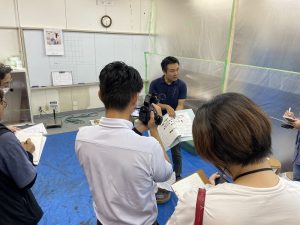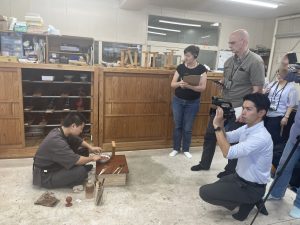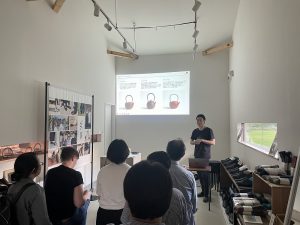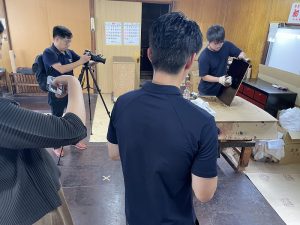実施日 : 2024年09月11日(水) - 12日(木)
Report: Iwate Press Tour : Passing On Traditional Industries to the Next Generation
投稿日 : 2024年12月10日
With Iwate Prefecture facing a declining and aging population, they are engaging in efforts to train the next generation of artisans in traditional industries and developing new products for export and to match modern lifestyles. This press tour was held based on the theme of “passing on traditional industries to the next generation,” focusing on urushi (lacquer) as a shared element in traditional handicrafts, in order to disseminate information on these efforts overseas through reporting by foreign media.
The journalists heard about how expanding lacquer production was an urgent issue, and saw how lacquer is harvested. They also covered efforts to train artisans to make lacquerware and Nambu ironware in the face of the declining and aging population, a Nambu ironware workshop actively engaging in overseas exports, and Iwayado tansu (chest of drawers) and lacquerware workshops developing new products matching modern lifestyles. At each stop on the tour, they met with people working to pass on traditions to the next generation.
A total of eight journalists participated in this press tour, from media based out of China, Germany, India, South Korea, Taiwan, and Vietnam.
*This press tour was sponsored by Iwate Prefecture, and planned and operated by the FPCJ.
*For details on tour stops, see the tour notice here.
・・・・・・・・・・・・・・・ Day 1 ・・・・・・・・・・・・・・・
< Konishi Decorative Arts & Crafts (Ninohe Branch) >
The tour visited the Ninohe Branch of Konishi Decorative Arts & Crafts, and heard from Mr. Tatsutane Fukuda, the company’s vice-president and head of the lacquer production division, about the basics of lacquer, how there was a current rush to increase domestic lacquer production due to the Agency for Cultural Affairs policy calling for domestic lacquer to be used in repairing Important Cultural Properties, and about training lacquer harvesters.
Next, the tour visited a lacquer tree grove, where they intently filmed and photographed a young lacquer harvester from Iwate demonstrating how to harvest lacquer by making cuts in a tree.
The journalists asked questions about how global warming affected growing lacquer trees and the difference in quality between lacquer produced in Japan and overseas. They also asked the lacquer harvester about what methods they used to harvest lacquer, and what a typical day of work was like.
< Ashiro Urushi Technique Research Center / Appi Urushi Studio >
The journalists visited Appi Urushi Studio, which uses the Appi-nuri style that is known for its simple designs, and the Ashiro Urushi Technique Research Center, where lacquerware artisans are trained.
First, at Appi Urushi Studio they heard from its representative director, Ms. Risa Kudo, about the characteristics of Appi-nuri and the background of the opening of the studio, as well as about its relationship with the Ashiro Urushi Technique Research Center. At the studio, the tour saw graduates of the Ashiro Urushi Technique Research Center applying and polishing lacquer. The journalists asked what kind of support they would like to have from the government for their business, how long lacquerware lasts, and whether they exported any overseas.
Next, the group went to the Ashiro Urushi Technique Research Center, operated by the city of Hachimantai. Mr. Fumitaka Fujiwara, who has been teaching at the center for approximately twenty years, explained about the long-running initiative to pass on a traditonal industry, and the center’s education system of teaching skills from the beginning instead of following a traditional apprenticeship system. The journalists then saw trainees of a variety of ages and from different areas training in applying lacquer.
The journalists asked questions about what trainees did after graduating, the reputation of the center, and what a typical day was like for a trainee.
The journalists visited Tayama Studio Inc., a Nambu ironware studio putting effort into training younger artisans. The journalists first heard from company president Mr. Takahiro Tayama an overview of Nambu ironware and about the Akai Ringo kettle, which was developed so rookie artisans could be involved in every step of the process from an early stage.
The group toured the studio and deepened their understanding of the process to make Nambu ironware, seeing young artisans in their 20s making sand molds, polishing, and heating lacquer to harden it, as well as seeing Mr. Tayama demonstrate applying a pattern to a sand mold.
The journalists asked numerous questions, about the possibility of using AI when making Nambu ironware, Mr. Tayama’s thoughts on how to pass on traditional beauty, and his feelings on passing on traditions to the next generation.
・・・・・・・・・・・・・・・ Day 2 ・・・・・・・・・・・・・・・
< OITOMI Inc. >
The tour visited Oitomi, a Nambu ironware business founded in 1848.
Mr. Kaito Kikuchi, Oitomi’s art director and ninth-generation owner, explained the company’s history, the origin of Nambu Ironware in the city of Oshu, how Oitomi was one of the first workshops to start exporting overseas in the 1950s, and how the company began focusing on e-commerce based off efforts to prevent overseas fakes.
The journalists then saw artisans making sand molds in the workshop, as well as casting molds that had been passed down for generations.
Questions included how Oitomi proved its products were authentic in response to fakes being made, whether the company had considered ideas such as putting IC chips in their iron kettles to prevent fakes, how they were operating and managing their e-commerce website, how Oitomi’s kettle was made differently from that of Tayama Studio that the tour visited on Day 1, and differences with overseas products.
< Iwayado Kagu Center / Kikuhiro Metal Carvings and Crafts >

The tour visited Iwayado Kagu Center, which makes Iwayado tansu known for their thick lacquer coating and fittings with gorgeous metal carvings.
First, company president Mr. Shinya Yaegashi gave an overview of Iwayado tansu, explaining their history and unique characteristics. The journalists then observed intently in the workshop as Mr. Yaegashi demonstrated his skills while explaining the process to make Iwayado tansu.
The tour also saw products from the Iwayado Kurashina series, which were designed to incorporate traditional techniques while fitting with modern lifestyles. The journalists were particularly impressed with the skills required when given a demonstration of a traditional tansu with hidden drawers called Shinobi.
The journalists asked questions such as where the lumber used for the tansu was grown, the impact of global warming, and what kind of customers generally bought tansu.
After visiting the Iwayado Kagu Center, the tour visited Kikuhiro Metal Carvings and Crafts, which makes metal fittings used for Iwayado Tansu, and heard from traditional craftsman Mr. Yo Oikawa about how the fittings are made and the traditional techniques used. The journalists then watched in fascination as Mr. Oikawa used various kinds of chisels in the workshop to demonstrate carving a traditional pattern in a metal plate. They also showed interest in Mr. Oikawa’s other initiatives using traditional techniques, such as making fittings and accessories based on photos of peoples’ pets.
The journalists asked about the details of the techniques used to carve metal fittings for Iwayado tansu, and developing new markets for metal fittings.
< Chuson-ji Temple Golden Hall (National Treasure/World Heritage Site) >
The tour visited the Chuson-ji Temple Golden Hall. 2024 marked the 900th anniversary of the hall’s construction, and in 2020 domestically produced lacquer (from Iwate) was used to repair cracks, with the work being performed by artisans from Konishi Decorative Arts & Crafts. The journalists were guided around the temple by the temple’s chief administrator Mr. Kocho Sugawara, who participated in the review meeting about the repairs to the Golden Hall. After seeing the Sankozo, which contains Buddhist statues made using lacquer, the tour visited the Golden Hall and heard an explanation of the repairs from Mr. Sugawara, while observing the spots that were repaired.
The journalists asked questions such as how the Buddhist statues were handled during the repairs, the background being the repairs being made to the Golden Hall, factors that could damage the Golden Hall, and about preserving Cultural Properties.
< Marusan Shikki >
As the last stop on the tour, the journalists visited Marusan Shikki, a workshop which produces Hidehira-nuri, known for its elegant decorations.
The fifth-generation president of the company, Mr. Makoto Aoyagi, explained the history of the company and the development of their new product series Fudan, made to match modern lifestyles.
The journalists then saw Hidehira-nuri being made in the company’s workshop, where they filmed and photographed the artisans’ skills close up. They also heard from Mr. Makoto Aoyagi’s younger brother Mr. Takuo Aoyagi, a lacquerware artisan and developer of the Fudan series, about the background behind developing the new brand and the challenges involved.
The Aoyagi brothers explained to the journalists their thoughts on how to pass on Hidehira-nuri to the next generation.
◆Below are some of the reports based on this tour.
Vietnam News Agency (Vietnam)
"Ninohe – Thủ phủ sản xuất sơn mài của Nhật Bản" (October 3, 2024)
"Đồ sắt Nambu - Biểu tượng văn hóa Nhật Bản" (October 15, 2024)
Vietnam Television (Vietnam)
"Độc đáo nghệ thuật tủ gỗ Iwayado Tansu Nhật Bản" (September 19, 2024)
JoongAng Ilbo (Korea)
"전통을지킨다는것" (September 19, 2024)
寰宇新聞 / 亞洲衛星電視 (Taiwan)
"900年受多次災害日本岩手中尊寺大翻修重生" (October 14, 2024)
第一财经 (China)
"无法量产的“伴手礼”,“匠人精神”的另一面" (October 30, 2024)






























